Today, after the rains of the past two weeks–and then a hot sunny midday–we had more species of odonates at the lily pond than I’ve seen yet this year. And the males all wanted a landing site on this stick:
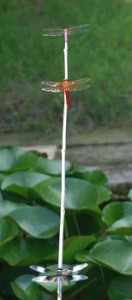 At the top (for the moment) is a Roseate Skimmer, Orthemis ferruginea, and below it a Neon Skimmer, Libellula croceipennis. Lowest is a Widow Skimmer, Libellula luctuosa. Smaller dragonflies buzzed the stick and sometimes drove off the larger ones–the Blue Dasher, Pachydiplax longipennis, seemed to be celebrating having the top spot:
At the top (for the moment) is a Roseate Skimmer, Orthemis ferruginea, and below it a Neon Skimmer, Libellula croceipennis. Lowest is a Widow Skimmer, Libellula luctuosa. Smaller dragonflies buzzed the stick and sometimes drove off the larger ones–the Blue Dasher, Pachydiplax longipennis, seemed to be celebrating having the top spot:
At least four male Blue Dashers were zipping around the pond. A lone Eastern Pondhawk male, Erythemis simplicicollis, chose to perch lower down on this stick.
When a female Eastern Pondhawk came to oviposit in the pond, this male and several Blue Dashers skirmished overhead.
The female stayed low to the water, dipping and scooping just like the Neon Skimmer female in a previous post. The female has the same green face as the male. This is the first time I’ve documented this species ovipositing in the water garden, though it shows up almost every year.
Ignoring all the excitement overhead, Desert Firetail damselflies, Telebasis salva, oviposited around the margin of a lily pad:
The males grip the females by the head; the females curl their abdomens under to lay eggs along the edge of the leaf, in the water. Sometimes in summer a lily pad will have a “fringe” of Firetails around it, the pairs all mating and then ovipositing.
I put up a second perching stick, and that gave more dragonflies a chance to land, but there were still more dragonflies than perching room. However, I got some solo portraits:
Widow Skimmer:
Neon Skimmer:
Roseate Skimmer:
Finally, another view of Dragonflies On a Stick:
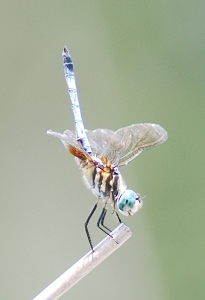
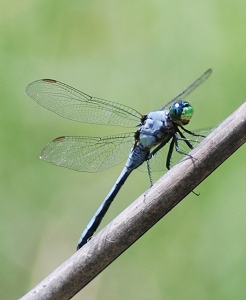
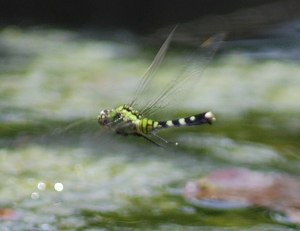
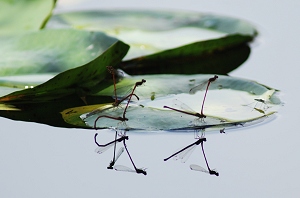
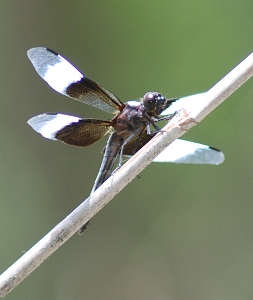
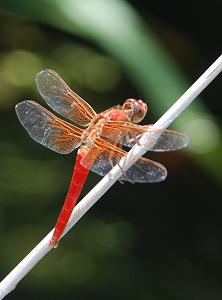
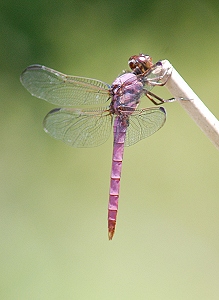
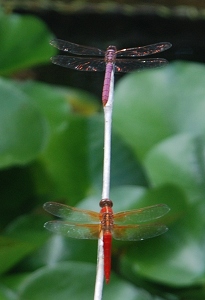
Comment by Steve Willson — July 9, 2010 @ 7:36 pm
That’s quite a colorful collection of dragonflies. How many species have you recorded at your water garden? I especially like the photo of the ovipositing Firetail damsels.
Comment by elizabeth — July 9, 2010 @ 8:01 pm
12 dragonfly species and 6 damselfly species in the yard, but a total of 40+ odonate species on the whole place (there are 49 on the species list, but I’m cautious about those I haven’t photographed, esp. those that I saw early in this project when I knew a lot less about dragonflies. 43 species have photo entries.)
Some never come into the yard but are found along the seasonal creek in years it has water, or in the woods, or flying/perched on the woods margin. Dr. Abbott at U.T. said I might have up to 50 species on the whole place, depending on the water supply each year.
Comment by Katrina — July 10, 2010 @ 8:14 am
Thank you for sharing these pictures.
Comment by green_knight — July 10, 2010 @ 8:42 am
Wow. Thanks for sharing. All I’ve seen this year are common blue damselflies – I _do_ have rather a lot of them, though. A couple of years ago I’ve had another species, but never managed to photograph them.
Sadly, my garden is too small for a pond.
Comment by elizabeth — July 10, 2010 @ 9:23 am
Odonates do perch and feed away from the water in which they reproduce, so your garden can be useful to them anyway. Damsels are weak fliers, so I find them on grass up to knee-high–most of those out in the big field are Common Bluets, but a few are Double-striped instead. The Argias (Dancers) I find in and near shrubbery and in the woods often on the ground or low plants. Dragonflies perch on tree limbs (esp dead twigs of trees and shrubs) sometimes in the shade. I was surprised to discover (once I started taking pictures) that all the blue damselflies aren’t the same species. But they’re so tiny I can’t see the markings of difference until I’m looking through binoculars or a long lens or blow the image up in the computer.
Comment by elizabeth — July 10, 2010 @ 9:27 am
So glad you’ve enjoyed them!
Comment by CathyH — July 10, 2010 @ 4:00 pm
The ones I see most often on the canal are a striking black and white; wonder if they’re your widow skimmers. So to continue our conversation from Twitter–you have camera thoughts/suggestions? My film cameras are all Canon and I have a certain amount of brand loyalty, but am open to a broader field of suggestions for digital cameras.
Comment by elizabeth — July 10, 2010 @ 4:32 pm
Canon makes excellent digital equipment used by a lot of wildlife photographers. I went with Nikon for the same reason you went with Canon–I had some Nikkor lenses that will fit my digital camera, but…I’m not using them. They’re compatible with the mount but they’re not fully automatic. Find a camera that fits your hands. I like being able to change lenses. As you probably know already, you generally get better glass in a fixed length than a zoom, but zooms are a lot better than they were. Tamron makes a 70-300mm zoom-macro (i.e., you can get a lot closer with it than you can with a standard 70-300 zoom) that is a perfect “walking around with Nature” lens. Not that much heavier than a normal lens, and for most things you won’t need a separate macro (though I have one and use it sometimes, it’s the least used of my lenses.)
Depending on how close you can get to the dragonflies, you might want to add a 1.4 tele-extender, because that gives you an effective 400mm lens. I use it with an old Nikkor 300mm (second hand from a newspaper) and that’s what took most of those dragonfly pictures. You can tell the diff between the Tamron (cranked out full to shoot the two multiple-dragon-flies on a stick from behind–I was maybe 10 feet from them) and the Nikkor (the others–but I have to be 15 feet away. And it’s heavy. And it reacts to hand tremor, breath, a touch of breeze, hence the monopod.) If you have an existing Canon lens that will work with one of their digital SLRs–esp. a 300 mm–you can probably learn to figure the exposure even if it act like an auto. But I’m now spoiled. I’ve also heard good things about the Canon Rebel, but I don’t know if it can change lenses. It’s supposed to have good zoom capacity. If you have a good camera store nearby, you are in luck–I found one in Austin and haven’t budged since.
Comment by Alex — July 10, 2010 @ 4:55 pm
Beautiful photos; I’m not sure if we have as many species of dragonfly over here. The ones I’m familiar with are long and an iridescent blue, but I’ve never seen red and pink ones.
Comment by elizabeth — July 10, 2010 @ 5:06 pm
I don’t know which countries have national odonate databases, with maps and things–in the past five years, Dr. Abbot at U.T. and others have put together Odonata Central, which covers the U.S. and I think part of Canada too. It has state and county checklists as well as photographs of many species (maybe even all by now.) You might find a reference like that for your area.
I was amazed, when we put in the lily pond, how quickly dragonflies showed up and how many kinds there were. I had to go get books, because I didn’t know anything about them.
Comment by Steve Willson — July 10, 2010 @ 7:40 pm
Thanks for the information. I just began seriously photographing and identifying the odonates last year. I’m up to 16 total, but there are still some I’ve not been able to get shots of.
Comment by elizabeth — July 10, 2010 @ 8:22 pm
I don’t think I got 16 the first year I was working on it…a female Widow Skimmer was my first (taken with the old point-and-shoot.) Getting a better camera a year later really helped, but it still took me years and I’m still not solid on all the males, females, and tenerals. One trick is to put ideal perching sticks up (the thing bamboo sticks sold in garden departments are ideal–like the one in the pictures here) so they slant out over your pond. The males love to perch over water and will hold still longer than elsewhere. Or some of them will. Odonata Central should have a list for your county of what you might have–and you might have one they don’t list for your county.
If you do, submit your photo to them for expert ID and they’ll put your data in the big database. (They did mine, for instance…the Turquoise-tipped Darner for Williamson County is my find.) And you can also do this with butterflies and moths, over at Butterflies and Moths of North America.
I found Sidney Dunkle’s Dragonflies Through Binoculars (Oxford Press, 2000) a really big help when I was first learning, though it covers only dragonflies, no damsels. I did learn a lot about dragonfly reproduction, parts of the body, etc. Then in 2005, Abbot’s book on the dragonflies & damselflies of Texas and the South-Central area came out and that includes both and has everything in my area–and much more background info. It’s not a field guide–a bit big to haul around–but for me it’s perfect. And of course BugGuide, where the pictures are bigger.
Comment by CathyH — July 11, 2010 @ 9:38 pm
Fantastic info–Odonata Central is a great resource, thanks for posting it!
My dad, who’s a bird photographer hobbyist himself, suggests a Canon SX20 IS, which is an awful lot of bang for the buck and would meet some of my needs for macro photography as well as zoom. It’s still a point and shoot camera when you come right down to it, but I’m not a great photographer, and I do want something that’s relatively lightweight and easy to use. So…. hmmm…. hmmm…. Turning 40 in 3 weeks, that seems like an occasion worth marking with a new camera. 🙂
Comment by elizabeth — July 11, 2010 @ 10:01 pm
I’m not familiar with that model, but Canon is an excellent manufacturer. I would see about trying one out–keep in mind the size of the bugs you want to shoot and how far away they are, and take some objects to the store with you, to see how they look through the lens at the distances you’ll be shooting. Any good camera store should let you try taking a few shots in the store to see if it works for you. Besides price–which we all have to contend with (I wouldn’t have my great Nikkor 300mm lens if I hadn’t gotten it second-hand!), I’d look first at the quality of glass (Canon & Nikon nearly always excellent) and how it works for what you want to do…and then buy pixels, as many as you can get. More pixels, more fun, esp. when your subjects are small or far away and you’re going to have to crop a lot to get the image a decent size. Oh–one thing to check–you want a camera that responds instantly to your finger on the trigger. Many digitals delay (while your subject gallops, hops, or glides away). Better digitals don’t. A friend and I were trying to analyze what a horse was doing, but the delay from button-push to ‘ka-lick!’ meant we never got a picture of the behavior we wanted to record (we wanted a particular part of a stride.)
But that’s my priority…everyone’s entitled to pick their own.
Comment by Adrianne — August 5, 2010 @ 9:16 pm
Somewhere along the line you mentioned I should look carefully at my widow skimmer’s wings. I finally got out there and caught a couple on camera today. Do males and females have different wing color? Some of them had black bands and white bands on their wings. Those guys wouldn’t hold still long enough for me to get a picture. Others have clear wings with a black band across the middle. All of them have the black body that looks like someone painted a white stripe down their tail.
Thanks,
Adrianne
Comment by elizabeth — August 5, 2010 @ 10:16 pm
Yes, males and females have different wing patterns and different body color. Females’ wings are black (but not a heavy dense black) and clear, with black near the body, then clear, then “smoky” wingtips. The body appears black with a yellow stripe (can look white at distance.) Males’ wings are densely black near the base, then white, then clear; their bodies are “pruinosed”–a pale wash over black–and can look whitish to powder blue depending on the angle of light and their age. Young males will look darker; older males look paler.
Clear wings with a solid black band across the middle are a different species: could be Common Whitetail (male, stout-bodied, appears whitish) or Band-winged Dragonlet (different shape/size, narrow bodied, dark.)
Comment by Adrianne — August 6, 2010 @ 7:54 am
I think you’re right. I think the pond has both widow skimmers and common white tails. I’ll have to go out and see if I can catch more dragonflies on camera. You realize that you’re getting me into shape hiking up to this stock pond. It’s up the mountain about two miles. There’s a meadow between here and there, and it’s fun to stop and look out over it. There are always dozens of dragonflies hovering over the grass. I had no idea that dragonflies liked to hunt over grass.